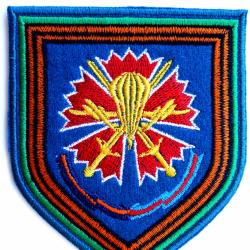Presentation of the seminar "teaching jumping rope to preschool children" presentation on physical education on the topic. Jumping rope We start jumping...
https://accounts.google.com
Slide captions:
workshop for physical education teachers topic: “Teaching jumping rope to preschool children” Elena Valentinovna Chernikova, physical education teacher of the highest category
How to choose the right jump rope for children Diameter 0.8-0.9 cm; The length of a short jump rope - the child must take it by the handles and step in the middle with his foot; the stretched ends touch the armpits; Long rope – 3-4 m.
Technique for gripping a jump rope by the handles The grip is carried out freely With the fingers turned forward The handles of the jump rope are directed downwards Squeezed between the thumb and the other fingers
Games and play exercises with a skipping rope Games with a skipping rope are one of the most effective auxiliary exercises; Jumping rope is used to warm up, strengthen leg muscles, improve coordination and mobility of the feet; An excellent tool for training the cardiovascular system, respiratory system, developing overall endurance and coordination; accessible to everyone, including children; Used both indoors and outdoors.
Technique for rotating the rope Rotation is carried out with slightly bent hands, elbows down.
1. Rotation of the rope, folded in half in the right (left) hand, forward or backward;
2.Also in two hands
3. Throwing the rope over yourself back and forth
4. Rotating the rope in pairs
Jumping rope technique Jumping in place; Arms bent at the elbows Torso straightened and maintaining correct posture Do not hold your breath Land softly on your toes, then lower onto your entire foot Push off with your big toes Jump 10-20 cm Observe rest periods between jumps
Methods of teaching jumping rope Younger ages Running under a rotating rope Stepping over a vibrating and elevated rope Rotating the rope back and forth with an attempt to step over and jump over it
Preview:
To use presentation previews, create a Google account and log in to it: https://accounts.google.com
Slide captions:
Middle age Jumping rope in a child-friendly way
Senior age Jumping in different ways: on the spot and in motion (relay races and competitions with individual jumps)
Cautions The load is given gradually The pace is adjusted The shoes are chosen correctly The warm-up includes exercises for the muscles of the toes and ankle joints
Exercises with a jump rope: Rotating the rope back and forth (3-7 years)
Rotate the rope forward and jump on two legs over the rope (3-7 years)
Jumping rope on two legs (5-7 years)
Jumping rope on one leg (5-7 years)
Jumping with one leg thrown forward, the other behind (4-7 years)
Jumping with alternating jumps from foot to foot with alternating legs (6-7 years)
Jumping with backward rotation of the rope, on two legs and from foot to foot (5-7 years)
Jumping with the rope rotated forward, legs crossed (5-7 years)
Rotation of a jump rope folded in half low above the ground with quick stepping and then jumping (3-7 years)
Jumping rope with crossed arms (5-7 years)
Jumping rope with forward movement, throwing out one leg and jumping from foot to foot (5-7 years)
Jumping rope in pairs (6-7 years old)
Jumping in place over a long rope, moving low above the ground back and forth (4-7 years)
Running under a rotating jump rope (3-7 years)
Jumping over a long rope with running and running away while it rotates (5-7 years)
Jumping over a long rope in pairs on the spot and with a run (6-7 years)
thank you for your attention
On the topic: methodological developments, presentations and notes
PROBLEMS OF TEACHING SENIOR PRESCHOOL CHILDREN TO JUMP ROPES
Jumping rope is a complex coordination motor action that requires the child to develop coordination and concentration, which is a complex manifestation of his physical qualities....
Topic on self-education: "Development of cognitive interest of preschool children through the use of multimedia presentations in working with children in the SRC"
Self-education topic: "Development of cognitive interest in preschool children and preschoolers through the use of multimedia presentations in working with children in the SRC"...
A jump rope is a time-tested sports equipment with a whole arsenal of possibilities. Rope exercises are performed by boxers, swimmers, speed skaters, volleyball players, etc. — it’s impossible to list them all.
View document contents
“Presentation on the topic “Jumping rope. Technique and benefits.””
Presentation on the topic “Jumping rope. Technique and benefits.”
Prepared by teacher Fofonova I.I.

What is a jump rope?
- A jump rope is a time-tested sports equipment with a whole arsenal of possibilities. Rope exercises are performed by boxers, swimmers, speed skaters, volleyball players, etc. - it’s impossible to list them all.
- And all because such seemingly “childish” jumps are capable of: 1. Increase endurance.
- Improve coordination of movements.
- Strengthen the cardiovascular system.
- Strengthen the muscles of the legs, arms, shoulders, buttocks and abs.
- Help you lose weight.

Jumping rope technique
Starting position for jumping
- Stand up straight.
- Throw the jump rope behind your back.
- Direct your gaze in front of you.
- Slightly bend your elbows.
- Move your hands 15-20 cm from your hips.
- While in the starting position, begin to rotate the rope.

Jump technique
- The landing should be soft, focusing on the balls of your feet (the front of the sole of your feet). In the basic technique of jumping on both feet, the heels should not touch the floor (there is a complicated version of jumping with an emphasis on the heel - the “boxer gait”, but this is an exercise for advanced jumpers). You shouldn't jump too high either. Literally a couple of centimeters from the surface will be enough so as not to interfere with the rotation of the rope.



Slide 2
Tasks:
Educational:
- Introduce students to the benefits of jumping rope.
Educational:
- Promote a healthy lifestyle; instill a love of movement.
Wellness:
- Improve health through physical exercise.
Slide 3
These are champions, masters from our yard -
They carry jump ropes in their pockets and jump since the morning.
In the courtyard and on the boulevard, in the alley and in the garden,
And on every sidewalk in plain sight of passers-by.
Both from the run and on the spot,
And two feet together...
Slide 4
All people want to look good. Every organism requires a healthy lifestyle and activity in order for its owner to look healthy and beautiful. Sooner or later, everyone comes to the conclusion that the most important factor in life is human health. Without it, many other conditions for a good and even normal existence are impossible. And if so, then it will always be a good idea to learn about the means to keep the body and spirit in good shape and health.
Even in physical education classes at school, everyone was forced to do a type of warm-up such as jumping rope. Many succeeded with a bang, but many people experienced significant problems with this seemingly simple physical exercise. What are the benefits of jumping rope for human health?
Slide 5
How long has it been since you picked up a jump rope? Most likely, in distant childhood. And in vain. A jump rope is a great exercise machine that fits in your pocket. So let’s evaluate the benefits of a jump rope...
Slide 6
The benefits that jumping rope training can bring you are undeniable, and this has been proven by the examples of many people, and especially athletes. Basketball players, volleyball players, track and field athletes, even heavyweight boxers - all of them cannot train without this equipment.
Slide 7
In terms of physical load on the body, jumping rope is comparable to intense walking, and to some extent, to accelerated running. During jumping, the human body is filled with the necessary amount of oxygen. Also, the benefits of jumping rope also affect the muscles of the arms, since they are also trained, and thirty times stronger than during intense running. The benefits of jumping rope are complex; during exercise, the entire body is trained and strengthened.
Slide 8
The benefits of jumping rope are also expressed in training coordination, willpower and constant self-control. First of all, they develop attention, speed and coordination. Anyone who has ever tried to do at least a few jumps without getting confused knows how difficult it is at the very beginning.
Next, different muscle groups are simultaneously involved: small and large calf and back muscles, muscles of the hands and arms, shoulder girdle, abdominal muscles and buttocks. For the harmonious development of the body, it is important that the muscles work together, and not each one separately. This big mistake is made by everyone who thinks that the gym will be the best place for a beautiful and healthy body. But no exercise machine will help you maintain an even posture the way a regular cord with two handles at the ends will do.
Slide 9
Active non-stop movements for just 5-10 minutes a day will greatly strengthen your cardiovascular system and develop an unprecedented amount of endurance.
Of course, along with the strengthening of the muscles, the fat layer on the waist, hips and buttocks will gradually begin to disappear, which is so important not only for any woman, but also for a man. This happens not only due to increased physical activity, since in addition the body’s metabolism accelerates, which means it stops storing fat in reserve, directing the energy received to restore recent expenses.
Slide 10
How to choose the right jump rope
The first thing you need to do if you have chosen this method of exercise to improve your health is to choose the right training item. The diameter of the “simulator” itself should not exceed nine millimeters, and the length should be selected based on height. To determine the length of the rope, you need to stand on it with your feet in the central part, pull the ends towards you so that they are at the armpits or slightly higher. If you take a jump rope that is too long, you may experience significant problems during training, because it will become more difficult to control your movements. A short jump rope will also be inconvenient; if you use it, you will have to constantly tuck your legs under you, and this will affect fatigue and ruin the entire training session.
Slide 11
How to learn to jump rope correctly?
The elbows should be pressed to the body, rotational movements should be made only to the hands. Your back should be straight and your legs should spring when you take off the ground and when you land. Jumps can be varied: regular, double, with a twisted rope, on two legs or on one, forward, backward and others.
Slide 12
Never handle this sports equipment if you have:
- obesity of 2 or more degrees;
- uncompensated hypertension;
- joint diseases;
- spinal disease;
- headaches of unknown origin;
- full stomach.
Slide 13
If you are allowed to jump rope, then organize the lesson correctly:
Before jumping, warm up your body with light jogging or regular exercise. Jump in comfortable sports shoes with thick, springy soles. Lift yourself off the ground no more than 2-3 cm - just enough so that the cord can easily pass under your feet and get tangled in them. You need to land on the balls of your feet, without your heels touching the surface.
- exercise daily;
- Duration of classes is 30–50 minutes.
- combine jumping rope with running and other physical exercises. Ideally, it might look like this: jog for 10–15 minutes, jump rope for 15 minutes, 15 minutes of other exercises and a final run;
- Watch your pulse. Normally, your heart rate should be less than (220 - age) * 0.6. For example, you are 15 years old. Then your maximum heart rate should not exceed (220-15) * 0.6 = 123 beats per minute.
Slide 14
Outdoor games with jumping
Game "Fishing Rod"
Game: All players stand in a circle, and the driver stands in the middle of the circle with a string in his hands. He rotates the rope so that it slides along the floor, making circle after circle under the feet of the players. They carefully monitor the movement of the rope and jump so that it does not hit any of them. The one who gets hit by the jump rope sits down. A player is considered caught if the rope touches him above the ankle. Players are not allowed to approach the driver while jumping. Jump rope for reference.
Game "Hares in the garden"
Preparation: On the site (in the hall) two concentric circles are designated, one large (diameter 8-10 m) is a vegetable garden, the other small (2-3 m) is a watchman’s house where the driver is located. Hares hunt in a large circle (in a field).
Game: At the leader’s signal, the hares jump (on two legs) into the circle and jump out of it. The watchman, having left his house, runs around the garden and tries to spot the hares. The hare, which has been spotted by the guard, is taken to the house, and the game continues until three or four hares are caught. After this, a new guard is selected - and the game is played again. Within the garden, hares are only allowed to jump. A hare that enters the watchman's house remains there. There are no winners - a game to lift your spirits.
Game "Easy Runners" (long jump rope)
Two people twist the rope, each holding one end. When the rope is untwisted by the 2 participants in the game chosen for this, each of the others in turn runs under the spinning rope, makes the agreed number of jumps in the agreed way and runs out from the opposite side, giving way to the next one. He repeats the task, giving way to the third; and so on.
Slide 15
Conclusions:
- You can practice with a rolling pin anywhere: on the street, at home, in the hallway, on the landing. Easy to use, convenient to store.
- My main task is to teach children to apply appropriate and effective methods in practice throughout their lives. And how they will use their knowledge and opportunities in the future is everyone’s personal business.
- In physical education lessons, a jump rope serves as an excellent sports equipment, both for developing leg muscles and for improving the functioning of the body’s cardiovascular system.
Slide 16
Conclusion
Well, it's time for us
Say goodbye to the jump rope
But I think that to all of you
It's a shame to part with her.
Therefore, guys,
Don't forget about her!
And play your games more often
Invite the jump rope!
Slide 17
Returning to childhood for just 10 minutes will give you a boost of energy for the whole day!
Galina Medvedeva
Presentation “History of the Jump Rope”
It's no secret that an unassuming item - a rope with handles, nicknamed « jump rope» , in fact, is a universal simulator, the like of which humanity has not yet invented. No one has recorded the exact date of its birth, but the ingenious simplicity of the projectile forces us to admit that people have found use for it since ancient times. Roman frescoes, images of wandering artists of the Middle Ages, later engravings and drawings depict actions similar to those that we can observe in every yard where children frolic after school.
According to English legends, jump rope- This is a reminder of the leather cord with which Judas Iscariot, who betrayed Christ, hanged himself. Jump ropes were popular in the spring, especially during Easter time. As a reminder, they were jumped on in Cambridge and East Sussex every Good Friday.
The ancient Egyptians and Chinese twisted ropes and cables from hemp. They constantly had to jump over them to keep them from getting confused. According to other sources, this jumping projectile was invented back in pagan Rus'; they were used by warriors during training. Another version of the appearance says that the first people to use this item were the first Christians who jumped on jumping rope during Easter
Gradually the game spread throughout the world. In the 18th century through jump rope started jumping boys: at that time it was not customary for girls to play sports
But a century later jump ropes have become popular entertainment among girls. It was then, in the 19th century, that three now common species appeared games: the person spins himself skipping rope and jumping, or jumps over jump rope, which two people twist for him, or jumps over two jump ropes, rotating in the opposite direction.
Publications on the topic:
Report “History of the Jump Rope” From its very inception, the jump rope was not just a rope for jumping. No one recorded the exact date of her birth, but...
Presentation “The History of the New Year Tree” Slide1 On its furry prickly paws, the Christmas tree brings a smell into the house: The smell of warmed pine needles, The smell of freshness and wind, And a snow-covered forest, And barely audible.
Presentation “The Story of One Furry Family” This happened in the summer, when my granddaughter and I were relaxing at the dacha. A cat came to us and soon she had kittens. That's what I'm talking about.
Presentation “History of the 8th March holiday” March 8. The historical roots of this holiday date back to 1901. German communist Clara Zetkin made a proposal to establish.
Presentation “History of New Year celebrations” Hello dear teachers! Just recently we celebrated the magical New Year holiday. This is a holiday that miraculously connects.
Presentation “The History of the New Year’s Card” Presentation on the topic "History of the New Year's card." New Year is a magical holiday and it’s interesting to learn something new on New Year’s Day, that’s why.
Presentation “A story about toys” Antique toys The presentation introduces toys of past times, toys from the times of our grandparents. dads and moms and with modern toys.
Presentation “History of Air Transport Development” Goal: to form children’s ideas about air transport and the history of its development. Objectives: develop logical thinking, speech, attentiveness.
"Gymnastics" - Beam. History of rhythmic gymnastics. Vaults. Performances. Women's floor exercise. Artistic gymnastics in the USSR. History of artistic gymnastics. Performance time. Exercises. Competitions. Gymnastics in the USSR. Gymnastics. Athlete. Gymnastics. Leningrad Rhythmic Gymnastics Championships.
“Gymnastics at school” - Rhythmic gymnastics. Technique for performing gymnastic exercises. Jumping in place. Educational objectives. Gymnastics in grades 5-11. Test lessons. Health objectives. Basic gymnastics. Sports types of gymnastics. Gymnastics is part of a comprehensive program. Safety regulations.
“Gymnastics as a sport” - Team gymnastics. Gymnastics. Hopper. Horse. Rings. Gymnastic ball. Gymnastics. Types of gymnastics. Gymnastics. Hygienic gymnastics. Types of gymnastic equipment. Bars. Sports acrobatics. Crossbar.
“Charging” - Exercise options for the main part. Since the 30s. school mathematical tests have become traditional. Load all the pushing muscles of the upper body. In 1973-74, the 1st All-Union O. “Student and Scientific and Technical Progress” took place. "Morning exercise is bad for your health." Chest, triceps, partially deltoids.
“Set of exercises” - Exercises to form correct posture. Classification of outdoor switchgear. Neck exercises. General developmental exercises. Health promotion. Dosage. Exercises for the whole body. Keep your head straight. Structure and content of a complex of general developmental exercises. Comprehensive effect on the body. Main stand.
“Fitball aerobics” - An active, fast person, proud of his slender figure. Fitball exercises. Using elements of fitball aerobics. Sets of exercises. The problem of human health, its preservation and strengthening. Exercises with this miracle ball. Identification of means, methods and rational forms of health-improving physical culture.
There are a total of 27 presentations in the topic






